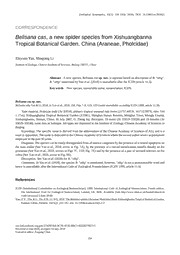
Belisana cas, a new spider species from Xishuangbanna Tropical Botanical Garden, China (Araneae, Pholcidae) PDF
Preview Belisana cas, a new spider species from Xishuangbanna Tropical Botanical Garden, China (Araneae, Pholcidae)
Zoological Systematics, 43(3): 334 (July 2018), DOI: 10.11865/zs.201825 CORRESPONDENCE Belisana cas, a new spider species from Xishuangbanna Tropical Botanical Garden, China (Araneae, Pholcidae) Zhiyuan Yao, Shuqiang Li Institute of Zoology, Chinese Academy of Sciences, Beijing 100101, China Abstract A new species, Belisana cas sp. nov. is reported based on description of B. "xtbg". B. "xtbg" mentioned by Yao et al. (2018) is unavailable after the ICZN (article 11.3). Key words New species, unavailable name, nomenclature, ICZN. Belisana cas sp. nov. Belisana xtbg Yao & Li, 2018, in Yao et al., 2018: 250, Figs 7–8, 11D, 12D (name unavailable according ICZN (1999, article 11.3)). Type material. Holotype male (Ar 33018), primary tropical seasonal rain forest (21°57.445'N, 101°12.997'E; elev. 744 ± 17 m), Xishuangbanna Tropical Botanical Garden (XTBG), Menglun Nature Reserve, Menglun Town, Mengla County, Xishuangbanna, Yunnan, China, 30 July 2007, G. Zheng leg. Paratypes. 10 males (Ar 33019–33028) and 10 females (Ar 33029–33038), same data as holotype. All types are deposited in the Institute of Zoology, Chinese Academy of Sciences in Beijing. Etymology. The specific name is derived from the abbreviation of the Chinese Academy of Sciences (CAS), and is a noun in apposition. The name is dedicated to the Chinese Academy of Sciences where the second author severs as permanent employee in the past 30 years. Diagnosis. The species can be easily distinguished from all known congeners by the presence of a ventral apophysis on the male endite (See Yao et al., 2018, arrow in Fig. 7A), by the presence of a curved membranous lamella distally on the procursus (See Yao et al., 2018, arrows in Figs 7C, 11D; Fig. 7E) and by the presence of a pair of serrated sclerites on the vulva (See Yao et al., 2018, arrow in Fig. 8B). Description. See Yao et al. (2018) for B. "xtbg". Comments. In Yao et al. (2018), the species B. "xtbg" is mentioned, however, "xtbg" is not a pronounceable word and hence is unavailable after the International Code of Zoological Nomenclature (ICZN 1999, article 11.3). References ICZN [International Commission on Zoological Nomenclature]. 1999. International Code of Zoological Nomenclature. Fourth edition. The International Trust for Zoological Nomenclature, London, UK. BHL. Available from http://www.nhm.ac.uk/hosted-sites/iczn /code (accessed 5 June 2018) Yao, Z.Y., Zhu, K.L., Du, Z.H., Li, S.Q. 2018. The Belisana spiders (Araneae: Pholcidae) from Xishuangbanna Tropical Botanical Garden, Yunnan, China. Zootaxa, 4425(2): 243–262. doi: 10.11646/zootaxa.4425.2.3 urn:lsid:zoobank.org:pub:27AF07AB-0C7E-4F35-BBC3-85D20778571C Received 4 June 2018, accepted 13 July 2018 Executive editor: Fuqiang Chen 334
